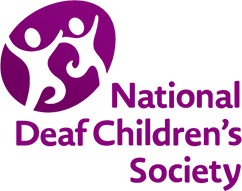Ivy's communication options
When Ivy, now nearly three, was diagnosed as profoundly deaf at nine months old, parents Marnie and Daniel knew little about the road ahead.
“It was like everything else stopped,” says Marnie, thinking back to the diagnosis.
Prepared for the diagnosis when it came, Marnie and Daniel had started researching deafness and what it might mean for their family. “We’d been reading a lot, and I’d spoken to a colleague whose academic research had focused on communication methods for deaf children. She suggested we start signing, and we knew it was something we needed to investigate,” says Marnie.
“We knew we had to give Ivy language"
Unsure what the future would look like for Ivy, yet determined to give her access to communication, Marnie and Daniel threw themselves into learning BSL. “We realised it could become her first language, and that we had to do it,” says Marnie.
The decision to sign was the first of many big decisions to come for the family when they realised how much change lay ahead for their daughter. Then living in a remote village in the Swiss Alps, access to services – especially signing – and the Deaf community was limited. “We knew we had to give Ivy language, and decided that we would best be able to support her with BSL,” recalls Marnie.
So the family began a long journey to create a new life in the UK, where Ivy could have much greater access to support. “It was all so overwhelming,” says Daniel, recalling the family’s visits to the UK before the move. “The National Deaf Children’s Society weekend and a sign language weekend (organised by Genie Networks) we attended were hugely influential,” he says. “We met deaf adults who used BSL as their first language, and realised what it would mean for us – we’d constantly be playing catch-up to increase our signing skills. But we knew what we had to do.”
Determined, Marnie and Daniel had passed BSL at Level 2 just four months after Ivy was diagnosed and had her hearing aids fitted. “The signing weekend was life-changing,” says Marnie, remembering it as the first time Ivy had spent time with deaf adults. “It was deeply moving to watch her engage and respond. It was clear that she was part of the Deaf community – and that we were welcome.”
“Our guiding principle was always to do whatever we could to broaden Ivy’s horizons.”
With BSL firmly part of their lives, Marnie and Daniel were surprised to discover that another option may be open to Ivy – a cochlear implant. Previously they’d been told that an implant wouldn’t be possible for Ivy because her cochleas weren’t formed. Later faced with the discovery that Ivy’s cochlea could be implanted on one side, Marnie and Daniel had no hesitation.
“Our guiding principle was always to do whatever we could to broaden Ivy’s horizons. That was the principle that led us to BSL – to get Ivy to a place where she could use language and communicate meaning – and that principle took us to the cochlear implant too,” says Daniel.
Ivy’s response following the implant switch-on took time, and now it’s unclear how much speech she can make out and how her English will develop. “We went into the implant hoping for the best, but we were never hanging our hopes for communication on it – we knew it may not be successful,” says Marnie.
Now the family use a mixture of speech and sign, and respond to what feels right at the time. “I sometimes read simple bedtime stories in English, with a bit of sign support, whereas Daniel tends to use BSL,” says Marnie. “Ivy’s BSL is years ahead of her English – that’s her first language,” says Daniel. “We’re potty training now, and that’s all happening in BSL.”
“In the future, Ivy won’t have to choose between our family and the Deaf community – she can be a part of both.”
Nursery is the latest milestone for the family, and the culmination of the decisions they’ve made so far.
“Every decision we’ve made has been to open up as many options as possible for Ivy, and give her full access to a first language,” says Marnie, excited by the opportunities a sign bilingual nursery brings for Ivy where BSL and English are used together in the classroom.
“She’ll have deaf role models and deaf peers, and that’s what we were aiming for. It just wouldn’t have been possible where we were living. In the future, Ivy won’t have to choose between our family and the Deaf community – she can be a part of both.”
